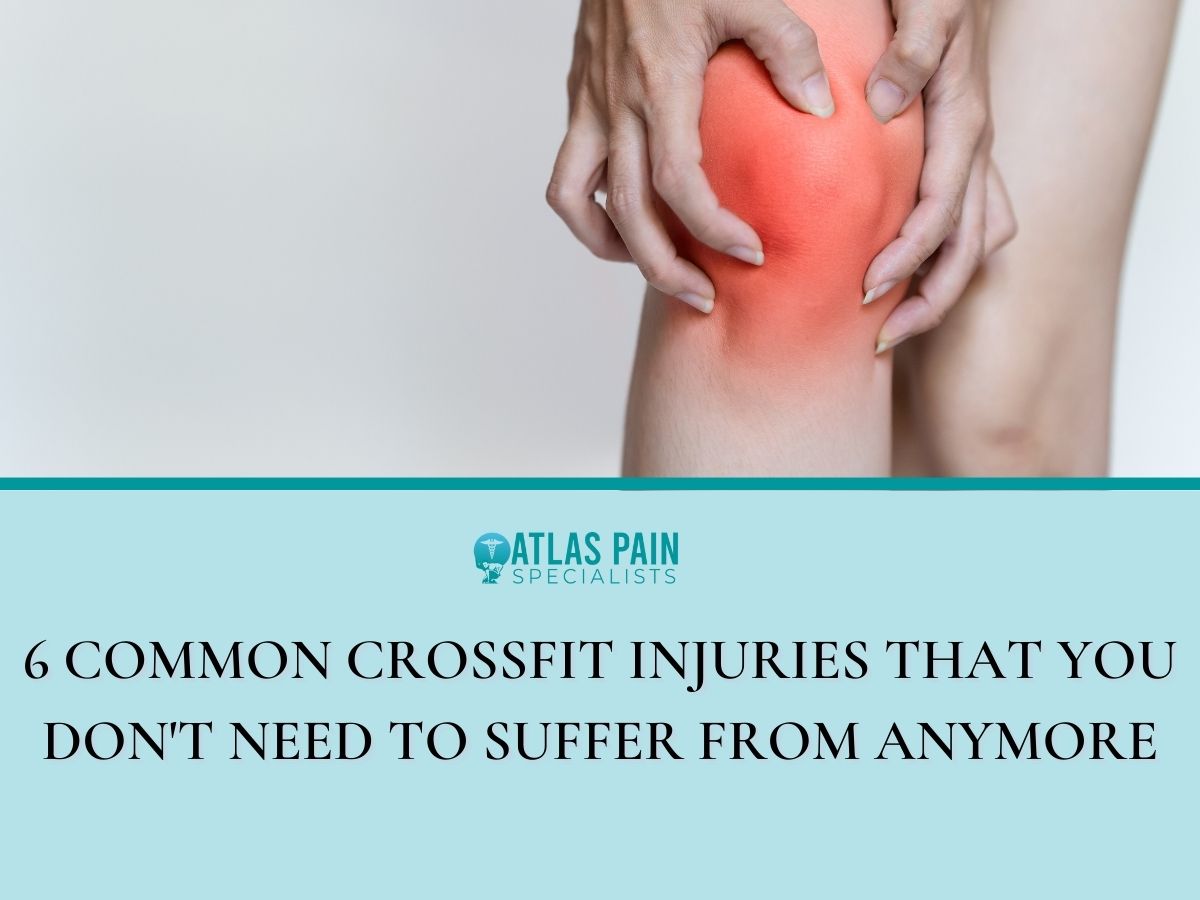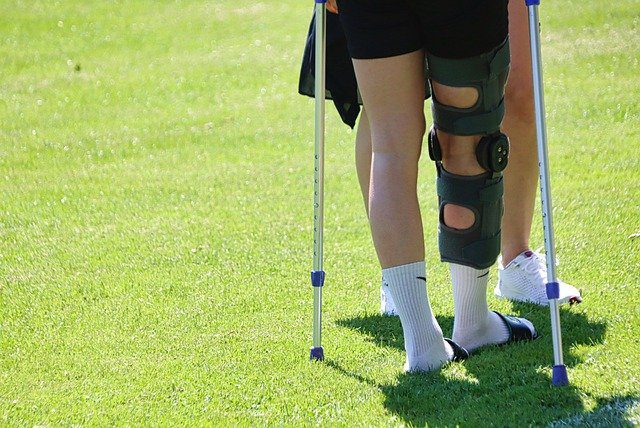

6 Common CrossFit Injuries That You Don't Need to Suffer from Anymore
CrossFit training is the major strength and conditioning program for many elite and professional athletes worldwide. CrossFit training increases strength and conditioning through extremely varied and tough workouts.
While demanding and encouraging, it helps people improve their physical health and cardiovascular fitness. No single aspect of your functional strength or fitness will be the focus of the workout; rather, you will strive to develop a body that is capable of doing practically anything you put it through.
This means that there are certain times the body will be put through more than it can handle for both strength and conditioning. This puts the body at risk of common Crossfit injuries, but most of the time, these injuries are avoidable.
Common CrossFit injuries: Why they happen
Overuse of muscles or the application of a force larger than the body component can physically withstand are the most common causes of CrossFit injuries. In the case of CrossFit exercises, the training is centered on constantly diverse functional motions executed at high intensity; you can be sure that soreness will arise at some point.
The most prevalent type of soreness we experience is Delayed Onset Muscle Soreness (DOMS). It's the sense of extreme tightness you receive in your muscles, such as your calves or abs, the day after a hard workout.
Eccentric contraction can result in DOMS. This happens when exercising a muscle beyond exhaustion or beyond its normal capacities, such as in pull-ups or squats.
It can also be caused by not hydrating or eating well before a workout and burnout and fatigue from not resting. Rest after a workout is important to avoid brain fog which can be a symptom of overtraining syndrome.
Six common CrossFit injuries that you don't need to suffer from anymore
Many young athletes may be on the verge of harming their own bodies through self-destructive behavior by disregarding their body's necessities. Overdoing the exercises and overstraining their muscles could lead to more than just DOMS.
Some of the six common CrossFit injuries you can avoid include:
1. Tennis elbow
Tennis elbow doesn't simply happen to tennis players and isn't limited to players only. The name is fairly deceptive.
It is known as lateral epicondylitis and is a painful condition that happens when tendons in your elbow are overused, commonly by repetitive motions of the wrist and arm. When you overuse the connective tissue that extends from the elbow to your wrist, you run the risk of inflaming the surrounding tendons.
Symptoms
The forearm muscles and tendons become injured from overuse leading to soreness and tenderness on the outside of the elbow. This makes doing things such as gripping objects and rotating your arm difficult.
Treating tennis elbow
Left untreated, tennis elbow may become chronic and linger for months and perhaps even years. Treatment should be focused on pain management to quicken the healing process instead of only correcting the issue that led to the pain.
Tennis elbow normally recovers on its own, but you can fasten the recovery period by using an elbow strap to limit movement, completing a range of motion exercises, undergoing physical therapy, and using prescribed medication for pain relief and icing the area in pain.
In severe circumstances, you may need surgery after 2 to 4 months of no response to conservative treatment. If the pain remains even after enough rest, it could be a case of nerve injury.
Stretching is necessary to prevent tennis elbow. After your workout, make careful to ice both elbows to alleviate any pain.
You can also do wrist extensor strengthening exercises and wrist extensor stretch to strengthen your forearms.
2. Muscle strain

When a muscle is overstretched or overworked, it can result in muscle strain. They are classified from grade one to three, with three being a complete rupture of a muscle or tendon.
A lot of swelling and inflammation occurs when the muscle is first injured, which causes sudden pain when engaging the muscle, swelling and bruising, and a loss of strength and range of motion.
Various muscles in the body are more susceptible to a strain injury, especially during CrossFit workouts, which involve most if not all of them. Some common strains include:
- Hamstring strain
Hamstring tendons join back-of-leg muscles to a thigh bone. Rapid acceleration activities cause most hamstring injuries.
Injuries range from sprains to ruptures, and consistent hamstring injuries might impair your flexibility. If you've previously had hamstring injuries from working out, you need to be more careful to avoid further injuries.
In case of a hamstring strain, seek professional care for a precise diagnosis and to avoid recurring injuries. The strain's severity may require a splint, physical therapy, or surgery.
- Wrist strain
A wrist injury is prevalent in CrossFit exercises. CrossFit routines incorporate a lot of weightlifting and wrist movements that put your wrists under a lot of tension.
If you don't warm up properly or wrap your wrists, you can avoid this injury. Strengthen your grip outside of the gym to reduce wrist strain during workouts.
- Lower back strain
CrossFit injuries are common due to repetitive, high-intensity activities like squats and deadlifts. Lower back injuries are therefore prevalent and if you have lower back pain, see a doctor or trainer before exercising.
Improper weightlifting form causes many back problems, and to avoid injuries, those with back discomfort should avoid deadlifts. You should consult a coach to optimize your deadlift form to avoid back injuries.
Stretch and warm-up before a workout and include your back's surrounding muscles. Upper back, glutes, hamstrings, and calves exercises alleviate back strain.
- Knee strain
Fibrous cords called tendons connect muscles to bones. The knee ligaments connect the lower leg and thigh bones.
A knee strain results from a torn muscle or tendon, which causes pain and swelling. Many sportsmen ignore knee pain or strain until it becomes painful and limit their exercise.
Knee injuries are prevalent in CrossFit workouts due to heavy lifting, jumping, and running. Knee injuries that cause pain should not be neglected.
3. Fractures
A fracture could be a stress fracture or a complete fracture (a bone crack or bone bruise). Stress fractures are common in the heels of the feet and the wrists, while severe stress fractures and bone breaks are caused by high-intensity exercises.
According to a sports science study, 60% of athletes who have one stress fracture will get another. Effectively treating stress fractures can prevent larger, harder-to-heal fractures or persistent problems.
Stress fractures cause prolonged pain and limited movement. Treatment depends on the location and severity of the stress fracture, and your doctor may recommend protective footwear or crutches, ice, and pain medicine.
Swelling, bruising, and pain are common symptoms of a shattered bone, as does bleeding if it breaks the skin (open fracture). Long-term use of the affected limb is unlikely as a broken bone might produce extreme discomfort, fainting, disorientation, or vomiting.
A repeated bone injury might lead to arthritis later in life. Immobilization with a splint or cast, traction to stretch muscles and tendons, pain medication, and surgery are all methods to treat bone fractures.
Fracture treatment is to reduce pain, speed healing, prevent complications, and restore body function.
4. ACL Injury
Exercise-active people can tear their anterior cruciate ligament (ACL) from knee trauma, especially during highly intensive workouts. ACL injuries originate from overstretching or ripping the ACL.
Tears are possible in actions involving abrupt stops, hops, or direction changes. Rest and rehabilitation exercises can help restore strength and stability following an ACL injury, or surgery can be performed.
After ligament replacement, athletes may need more surgery. Your knee ligament may never recover, increasing your risk of re-injury.
You, therefore, need to be careful if you've once had an ACL injury.
5. Shoulder injury
As a ball-and-socket joint, the shoulder is prone to injury during CrossFit. The rotator cuff helps strengthen your arms, chest, and back.
CrossFit exercises involve people to the extent that they might push so hard that their shoulders pop. This causes generalized edema, shoulder form loss, and arm movement restriction till the injury heals.
If you've had a shoulder dislocation, you risk another as dislocations are recurrent. Shoulder dislocations strain ligaments, and to limit the chance of re-injury after a shoulder dislocation, consider arthroscopic stabilization.
A complex network of tendons and muscles in the shoulder allows for arm lifting and rotation. A rotator cuff injury or supraspinatus tendinitis, for example, might be painful and impair a person's arm movement.
Pull-ups and presses can cause CrossFit injuries. To avoid this condition, strengthen the rotator cuff muscles and lighter weight and rep your deltoid muscles.
Stretch and ice after workouts to nurse any developing injuries.
6. Jumper's Knee

Patellar tendonitis, or Jumper's Knee, is caused by damage or inflammation to the tendon that links the kneecap to the shinbone. Overuse causes Jumper's Knee in CrossFit sports, including running, jumping, and squatting.
Depending on the tendon tear, swelling and pain may be modest or severe. Box jumps and other high-impact activities strain the lower leg.
Patellar tendonitis causes knee pain, especially below the knee. Patellar tendinitis can be avoided by stretching before and after activity.
Above all, focus on the tibialis anterior. Slowly flex and release the middle resistance band.
Treatment and prevention of CrossFit injuries

If you've been injured, don't give up on your favorite sport. Physical therapy, on the other hand, can help you avoid injury.
1. Self Myofascial Release
The pain improves with time in the case of DOMS. They won't be relieved by massages, and overusing a foam roller or similar equipment can aggravate a sore spot.
These practices can hinder your body's regular recovery. White blood cells rush to micro-tears in muscles induced by vigorous exertion, causing soreness.
Overstretching and mashing damaged muscles may cause extra harm and slow recovery. Remember that unpleasant stretches are optional.
2. Be Proactive
Long-term, preventative fitness can prevent CrossFit pain. Mobility, rest, and nutrition are important.
We know that muscle contraction causes pain, and we must therefore strengthen our flexibility or mobility.
CrossFit injuries from overtraining
Overtraining promotes fatigue, sluggishness, and injury. CrossFit trains several body areas, and as much as specialization is rewarding; athletes should fully recover after intense training.
Overtraining without rest might affect performance and health if there is minimal rest. Along with exercise and rest, watching your nutrition helps with your recovery.
Consult your coach, trainer, or doctor if you suspect you've overtrained. Professionals in sports medicine can help you recuperate.
In addition to sleep, diet, and mental health, coaches should be aware of any issues their athletes may have with hard training and explore whether training needs to be altered.
Your doctor and trainer can tell you when you can resume exercise. Everyone's recovery is different, and trying to return to full training too soon will result in a lengthy recovery.
Follow experts' recommendations for faster recuperation.
How to avoid CrossFit-related injuries
The best way to prevent CrossFit injuries is to avoid them in the first place, whether you're already showing signs of exhaustion, pain or just want to be on the safe side as you increase your workout intensity.
Here are tips to help avoid such injuries:
1. Pay attention to what your body is telling you. Let your coach or doctor know how you feel so they can help you.
2. Keep track of your workouts. Record how you're feeling and how much exercise you're doing; a training record shows your progress and if you are overdoing something.
3. Balance your workouts with rest periods. A lack of sleep does not imply a lack of strength, and it is best if you take a full day off once a week.
4. Alternate hard and easy exercises if you're training for a certain sport. Cross-train, take active breaks during your workouts, and make modest adjustments to your workout as you raise the volume and intensity.
5. Be honest with yourself when you're overdoing it and seek help. Talk to a friend or family member about your sentiments if you find yourself becoming obsessed with training, working out despite discomfort or injury, or feeling terrible if you miss a day of hard activity.
6. Don't skimp on your caloric intake or your nutritional requirements. Calorie requirements for training and muscle regeneration should be included in your diet, and you can consult a nutritionist for more help.
7. Drink plenty of water. Muscle tiredness is exacerbated by dehydration.
8. Avoid stressful situations and activities. Stress affects each person in a unique way. When you're under more stress than you can handle, your body starts to malfunction.
If you're having problems with your training, job, family, friends, social life, body image, finances, travel, or free time, you might benefit from consulting with a mental health specialist.
Frequently asked questions
How can you prevent CrossFit injuries?
CrossFit exercises involve high-intensity workouts done at high-intensity intervals. While CrossFit injuries are prevalent when first starting out, there are a few basic things you can do to help prevent them.
1. Get a regular physical checkup: Before starting an activity plan, get a fitness checkup from your doctor. Any new workout can stress your body.
2. Hire a PT: A personal trainer can help you get started safely and construct a fitness plan depending on your goals. A good trainer can help you avoid many of the bad habits that hinder even the best athletes and those that lead to injuries.
3. Slowly increase your workout: Beginners often train at an unsustainable and harmful intensity. Start with 20 minutes of low-intensity exercise three times a week, then build up.
4. Warm-up before exercises: Many people start workouts without warming up or stretching. Even if you're in shape, your muscles and tendons will be sore and stiff in the gym, and you risk overextending or twisting a joint which can cause injury.
5. Eat well: Exercise burns calories and produces sweat. Eating the right foods two hours before an exercise gives you energy.
Similarly, hydration. Two hours before exercise, drink at least 16 ounces of water.
6. Sport-specific gear is crucial: Insufficient clothing and footwear can cause sports injuries. If you're unsure, consult a trainer for help.
7. Heed to your body's needs: "No pain, no gain" is a fitness cliche. A difficult workout shouldn't hurt, and you should reduce the intensity or switch muscle groups until your body can handle the new workout.
8. Avoid exercising if you are sick: When you work out, your immune system revs up. Exercise can weaken your immune system, and overtraining is as unhealthy as undertraining.
About Dr. Sean Ormond



